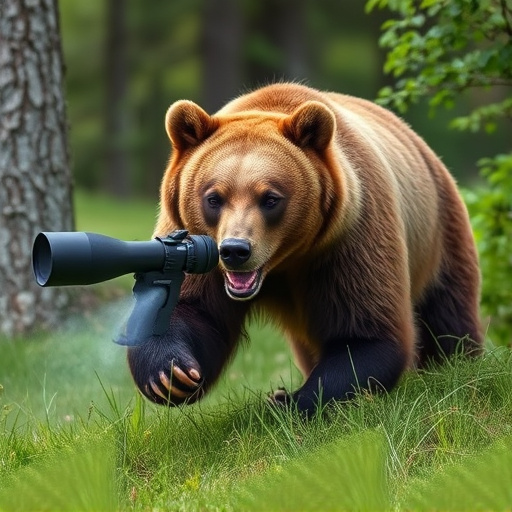Understanding bear behavior and adhering to TSA rules for bear spray usage are crucial for safe outdoor activities in bear habitats. By making noise, avoiding peak feeding times, carrying bear spray (under 3.4 ounces in carry-on luggage), and correctly applying it at a distance of 20-25 cm, hikers can minimize risk of encounters and ensure safe interactions with bears. Always check individual airline policies and consider regional bear types for optimal protection.
“In areas where bears roam, knowing how to prevent and respond to attacks is crucial. This guide explores effective strategies using bear attack prevention spray, a vital tool for outdoor enthusiasts. We delve into understanding bear behavior, adhering to TSA rules for carrying bear spray, and selecting the right product. Learn the art of proper application techniques to ensure maximum protection during your adventures in bear country. Stay safe, stay informed – know your TSA Rules for Bear Spray.”
- Understanding Bear Behavior and Their Sensitivities
- TSA Rules and Regulations for Carrying Bear Spray
- Choosing the Right Bear Attack Prevention Spray
- Effective Application Techniques for Maximum Protection
Understanding Bear Behavior and Their Sensitivities
Understanding bear behavior is crucial when considering outdoor activities in their habitats. Bears are wild animals with complex instincts and sensitivities, which can often be triggered by human presence. They have a keen sense of smell, hearing, and vision, making them easily disturbed by unexpected noises or sudden movements. In many regions, bears are protected by law, and approaching or disturbing them is prohibited. The Tsa (Transportation Security Administration) Rules for Bear Spray recognize these factors and provide guidelines for its effective use as a deterrent.
Bears typically avoid humans unless they feel threatened, are protecting their young, or have been provoked. Proper precautions include making noise while hiking to prevent ambushes, avoiding known bear habitats during peak feeding times, and always carrying bear spray as a last resort. Understanding these behaviors can help hikers and outdoor enthusiasts minimize the risk of encounters and ensure safe interactions with these majestic creatures.
TSA Rules and Regulations for Carrying Bear Spray
The Transportation Security Administration (TSA) has specific rules and regulations regarding the carrying of bear attack prevention spray, or bear spray, on aircraft. According to TSA guidelines, bear spray is permitted in carry-on luggage, provided it meets certain criteria. The canister must be 3.4 ounces (100 milliliters) or less in size, and it should be secured within a separate, closed bag to prevent accidental discharge. Additionally, the TSA requires that the spray be non-aerosol, meaning it shouldn’t emit a mist when triggered, unlike traditional aerosol sprays.
Travelers must also ensure they present the bear spray for inspection at security checkpoints. This includes showing the packaging and demonstrating how to activate the device. Remember, carrying bear spray is subject to individual airline policies as well, so double-check with your specific carrier for any additional restrictions or requirements before your trip.
Choosing the Right Bear Attack Prevention Spray
Choosing the right bear attack prevention spray is crucial, especially given the varying needs in different regions and conditions. Key factors to consider include the type of bear you’re facing, local TSA (Transportation Security Administration) rules for carry-on luggage, and the specific active ingredients in the spray. For example, black bears typically require a shorter range and lower pressure spray compared to grizzly bears or brown bears.
When selecting a spray, ensure it complies with TSA guidelines, allowing you to carry it onboard flights. This usually means a can size of 3.4 ounces (100ml) or less, stored in a clear quart-sized bag. Additionally, familiarize yourself with the recommended usage distance and angle for maximum effectiveness, as well as any instructions for reapplication after contact with water or heavy breathing.
Effective Application Techniques for Maximum Protection
To ensure maximum protection from bear attacks, proper application techniques are crucial. Start by checking the Tsa Rules for Bear Spray to understand restrictions and usage guidelines. Hold the can upright, about 20-25 cm (8-10 inches) away from your face, and target the bear’s face, eyes, and nose. The goal is to create a barrier of aerosol, covering as much of the bear as possible.
Avoid spraying in a sweeping motion or towards yourself, as this can create a mist that reduces visibility and effectiveness. Instead, use quick, short bursts until the bear retreats. Reapply if necessary, especially after coming into contact with sprayed bears, as it may have blown away or worn off. Regular practice can help you become more comfortable and proficient in these techniques, ensuring better outcomes during potential encounters.
When venturing into bear country, having the right prevention spray and knowing how to use it can be a game-changer. Understanding bear behavior and adhering to TSA rules for carrying bear spray ensure you’re prepared for any encounter. Choose a high-quality spray that suits your needs, and practice effective application techniques to maximize protection. Remember, knowledge is key when navigating this wild landscape.
